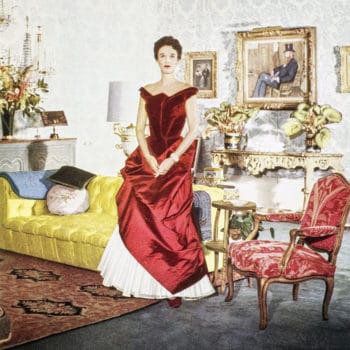
Was Charles James Fashion’s Most Unreasonable Man? A New Biography Makes the Case
As anyone who saw the Metropolitan Museum of Art’s 2014 Costume Institute exhibition “Charles James: Beyond Fashion” will know, the designer was a self-acknowledged genius of fashion whose mastery of cut and construction earned him an enviable clientele that included the best dressed swans and tastemakers of his generation, from the Countess of Rosse and Millicent Rogers to Babe Paley, Austine Hearst, Dominique de Menil (for whom he designed the interiors of a Philip Johnson house), and even the celebrated ecdysiast Gypsy Rose Lee (who ended her burlesque performances elaborated dressed by James). “It is his boast that he never had an uninteresting client,” wrote his publicist Eleanor Lambert in 1954, when her client (and subsequent nemesis) won a prestigious Coty Award. “Brancusi had his medium, Picasso, Faulkner, Shostakovich theirs,” said James, with characteristic conceit. “Mine happens to be cloth.” His peers agreed: Cristóbal Balenciaga called him “not only the greatest American couturier, but the world’s best,” a creator who elevated dressmaking “to a pure art form.” Virginia Woolf called him “a genius.” Salvador Dalí described James’s work as “soft sculpture,” Christian Dior called him “the greatest talent of my generation,” and Chanel and Schiaparelli paid him the highest compliment of all by ordering his clothes to wear themselves.
James worked and reworked his clothes until they met his exacting standards, terrorizing his seamstresses and protégés, and exasperating his clients as he turned his creative, emotional, and mental struggles into garments that would be constantly torn apart and remade in the interest of perfection—and often never delivered at all. Throughout his peripatetic career (he made garments in Chicago, London, Paris, and New York), James was not only innovating with forward-thinking ideas about branding and licensing, but was also constantly battling bankruptcy and endless litigation so that his lifetime’s output was relatively modest. In some instances, his innovations also compromised the actual fabric of the clothes. Harold Koda describes the “inherent vice” of many of his garments: “These gowns of once unparalleled glamour, in their state of poetic devastation, might be the most evocative metaphor for James himself,” he writes. “They are beautiful ruins, still redolent of a heroic, wildly creative ambition and unfettered, self-destructive genius.”
James was a man as complex and demanding as his clothes, as Charles James: Portrait of an Unreasonable Man: Fame, Fashion, Art, the elaborately titled biography by Michèle Gerber Klein and published by Rizzoli Ex Libris, makes clear. Born to Edwardian privilege, James died in squalor and penury at the Chelsea Hotel, surrounded by his expressive drawings, toiles, and the garments that he was still in the process of refining.
James had apparently intended to write a book about the clients who had influenced his work: “Designers are only hired help that copy what is in the wind,” he noted acerbically, “They don’t create fashion. Only the couturier does, with his client as inspiration!” The book never materialized, but Klein boldly picks up this thread, focusing on the remarkable women who inspired, patronized, supported, and fought with James through the years, from Elizabeth Arden and Elsa Schiaparelli to Eleanor Lambert and Nancy Lee Gregory, whom the famously queer designer surprised his friends by marrying in 1954. (20 years his junior and an heiress to a successful Midwestern insurance company, she was previously married to James’s lover Keith Cuerden. James fathered two children with Gregory, Charles Jr. and Louise, and they in turn inspired his designs.)
Klein has drawn heavily on some 40 hours of interviews, filmed by Anton Perich, with R. Couri Hay and James in 1977, shortly before his death, and intended for another autobiography that also never materialized. In these interviews, James bars no holds. The revered Vogue editor in chief Diana Vreeland, for instance, is, in his estimation, “one of the parlor maids of fashion . . . I don’t know anyone less informed . . .” Halston, a sometime protégé who employed James as a sort of design consultant when he was living on his uppers, is dismissed as “a middle-of-the-road man who would be better as a buyer in the store or a stylist . . . The word plagiarism is correct.”
James seems to have met, befriended, loved, or reviled most of the 20th century’s great fashion and style makers, from Paul Poiret to Antonio Lopez, and this book is a who’s who of those glittering, fascinating characters. The impossible Mr. James emerges as one of the most compelling of them all.
View Full Article on Vogue

